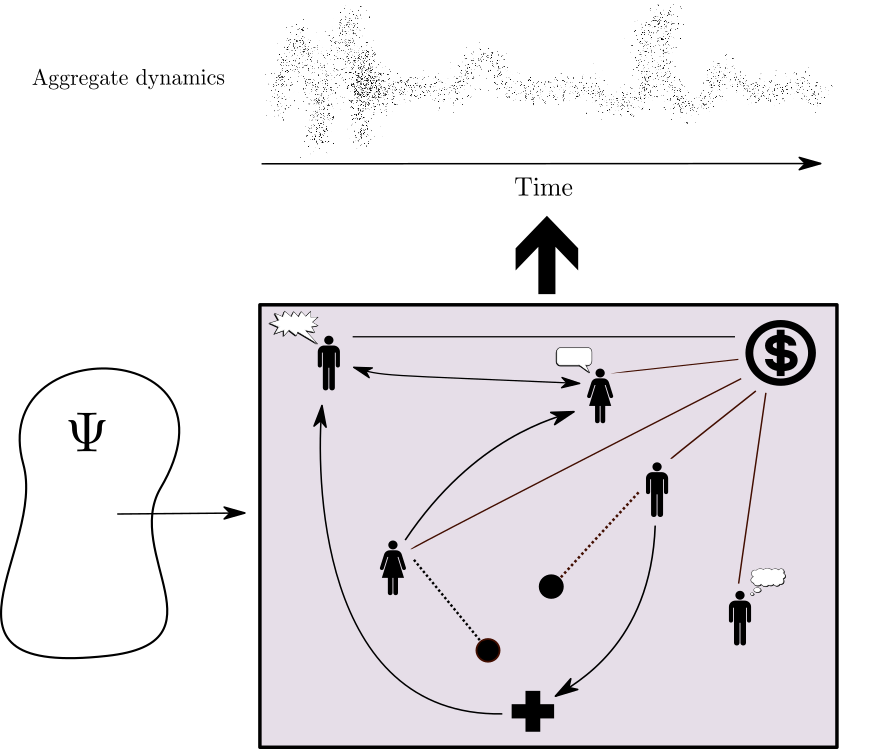Agent-based models of opinion dynamics
 Researcher: Joel Dyer
Researcher: Joel Dyer- Academic Supervisor: Prof. Doyne Farmer
- Industrial Supervisors: Patrick Cannon, Stefano Romano
Background
Improbable is dedicated to the generation of large-scale complex simulations and virtual worlds for the purpose of assisting real-world decision making. In particular, they are interested in constructing agent-based models (ABMs) of social systems. ABMs are computational models consisting of a set of autonomous, decision-making entities (e.g. firms, humans, governments), the environment in which they operate, and the relationships and interaction rules that govern their individual and collective dynamics.
ABMs have received growing attention within economics as an alternative to traditional models. As a result of historical and cultural influences, traditional economics sought to develop a framework for economic modelling akin to that of Newtonian mechanics in physics. The outcome of this historical trajectory is the canonical dynamic stochastic general equilibrium (DSGE) class of macroeconomic models, and a standard set of strong assumptions made about the behaviour and interactions between model agents: rational expectations, instantaneous propagation of price-adjusting information, and perfect competition are examples. Modelling within this framework broadly proceeds by issuing random “shocks” to the model and solving for the new equilibrium in which the model settles.
The development of DSGE models and this standard set of assumptions can be seen as having been necessary for the sake of model tractability. However, the inability of these models to explain, let alone predict, significant economic events such as the 2007-09 financial crisis has led some economists to view these traditional models as fundamentally inadequate. Developments in behavioural economics and cognitive psychology have shown that human behaviour – the fundamental driver of economic activity – is far from rational, with biases and errors being the norm rather than the exception. The method by which technological innovation proceeds – human economic activity – suggests that exogenous “shocks” would be more accurately represented as innovations arising endogenously from the model specification. Thermodynamics suggests that a framework in which human systems are viewed fundamentally as open and non-equilibrium in nature is more faithful to reality. The sciences of networks and complex systems – offshoots of statistical mechanics in physics – provide such a framework. Agent-based simulation models are a manifestation of these approaches, and have been enabled by advances in computational power seen in recent decades.

Figure 1: A schematic of an agent-based model. The models input parameters $\psi$ and forward simulates the agent-agent (arrows) and agent-environment (dotted lines terminated by circle) interactions to produce microstates that are subsequently aggregated to generate macro-level dynamics.
The flexibility of these computational models come with a cost, however. Since ABMs are inherently computational, the model they represent is defined implicitly in the software that simulates the model dynamics. Thus while it is straightforward to forward-simulate the ABM to generate output, it is not generally possible to construct a closed-form expression for the model’s likelihood function, nor to evaluate the likelihood on a point-wise basis. This makes inferential problems, such as parameter estimation, difficult. This project is concerned with techniques for estimating parameters in such complex stochastic simulation models.
Background
We have investigated the ability of a variant of a class of techniques known as “simulated minimum distance” to accurately recover the parameters of an ABM. This method is called indirect inference. Given empirical data, the method involves: constructing a surrogate model with known/tractable likelihood and therefore for which parameter estimation is straightforward; constructing a mapping from the ABM parameters to the surrogate model parameters; and maximising the surrogate likelihood of the empirical data. The “maximum likelihood” ABM parameters are then implied as the solution to the surrogate maximum likelihood problem under the chosen ABM parameter-surrogate parameter mapping. Our experiments so far have shown that for the ABMs we have considered, this approach is able to recover the parameters of the ABMs to some extent, but that more sophisticated alternative methods provide more accurate and precise estimates.

Figure 2: A schematic of the indirect inference structure. The real world produces empirical data $y_1,\ldots,y_T$, and we are concerned with estimating the parameters of an agent-based model $\psi$ that control the shape of its unknown likelihood function $Q_\psi$. The surrogate model, with tractable likelihood $P_\theta$ provides the eyepiece through which we can indirectly observe an approximation to $Q_{\psi}.$
Future Work
Future work on this problem will involve the consideration of more flexible surrogate models and the extension of this approach to the Bayesian framework. For this problem, there is a trade-off between performance of the method and practical aspects such as overall estimation time and ease of implementation. These latter aspects are important points for consideration: development of an estimation method that is both maximally performant and maximally usable is instrumental to the widespread adoption of agent-based modelling and the utility of this modelling approach in policy environments.

